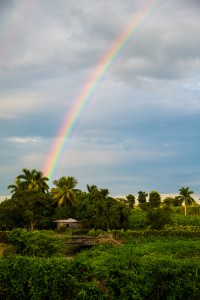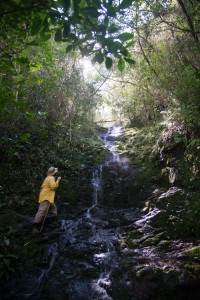Exploring the Mountains of Eastern Cuba, Part I
Posted in Travelogue on April 24, 2014 by Fabian Michelangeli
Fabian A. Michelangeli, Ph.D., is an Associate Curator of the Institute of Systematic Botany at The New York Botanical Garden. His research focuses in part on the evolution, identification, and classification of neotropical plants.

A recent expedition to eastern Cuba took three Cuban colleagues and me from the coast to the cloud forests in search of rare and locally restricted species in the plant family known as princess flower or meadow beauty. The species in this family (whose scientific name is Melastomataceae) are an especially diverse group in Cuba.
Joining me were Dr. Eldis Becquer from the Jardin Botanico Nacional (National Botanical Garden) in Havana; Wilder Carmenate, director of the Holguin Botanical Garden; and Jose Luis Gomez, a researcher at the Holguin garden and a graduate student at the University of Havana. Becquer, Carmenate and I are studying the Melastomataceae while Gomez and Carmenate took advantage of this expedition to document invasive species—part of ongoing research projects developed by Carmenate to study threats to the flora of Cuba.
The first area we targeted was the Turquino National Park in the Sierra Maestra Mountains of southeastern Cuba. This park contains some of the best-preserved cloud forests in the Caribbean, as well as the Pico Turquino, the tallest mountain on the island at almost 6,500 feet. During five days spent in the area, we reached the summit of three of the highest points in Cuba—Picos Turquino, Joaquin, and Regino—and we collected plants on both the southern, Caribbean-facing slope and the northern, inland-facing slope of the Sierra Maestra. This allowed us to contrast different exposures to rain and sun, as well as different soil types and vegetation.
From the Sierra Maestra, we crossed the island towards the Sierra de Moa Mountains on the northeastern coast. For the next few days, we centered our collections around the locality of La Melba in the Alejandro de Humboldt National Park, where in a very short distance we could go from the coast up through pine forests and to the summit of the mountain, with rain or cloud forests.
Lastly we collected in areas near the city of Moa in the Cerro Miraflores, in coastal serpentine deposits in Yamaniguey, and inside the mining concession of Santa Teresita. This last locality was especially important because it is scheduled to be opened to mining in the near future, so this could be one of the last chances to document the species that are there. It is the habitat of many plants that are rare or endemic, meaning they are found only in that place.

At all localities, we relied on the logistical support of the national park system of Cuba or the Office of Flora and Fauna (equivalent to the U. S. Fish and Wildlife Service). They provided housing at local lodges or ranger houses, helped with food, and provided us with work space to process our samples. Local park rangers at every site also joined us as guides and helped collect plants. An important part of our activities was to train them to identify not only rare plants but also aggressive invasive species that are being targeted for removal.
In total, we collected more than 70 species of Melastomataceae. Of these, more than 80 percent are found only in Cuba and 90 percent only in the Caribbean islands, underscoring the high level of endemism in the forests of these islands. In the coming weeks, Science Talk will detail some of the species collected during our time in the mountains of Cuba.


Hello I am a lepidopterist from UK. Read your blog on exploration around Yamaniguey. I am planning visiting that area this summer to look for butterflies. Are there any hotels or Casa Particulares nearby.
Information from you would be helpful.
Thank you